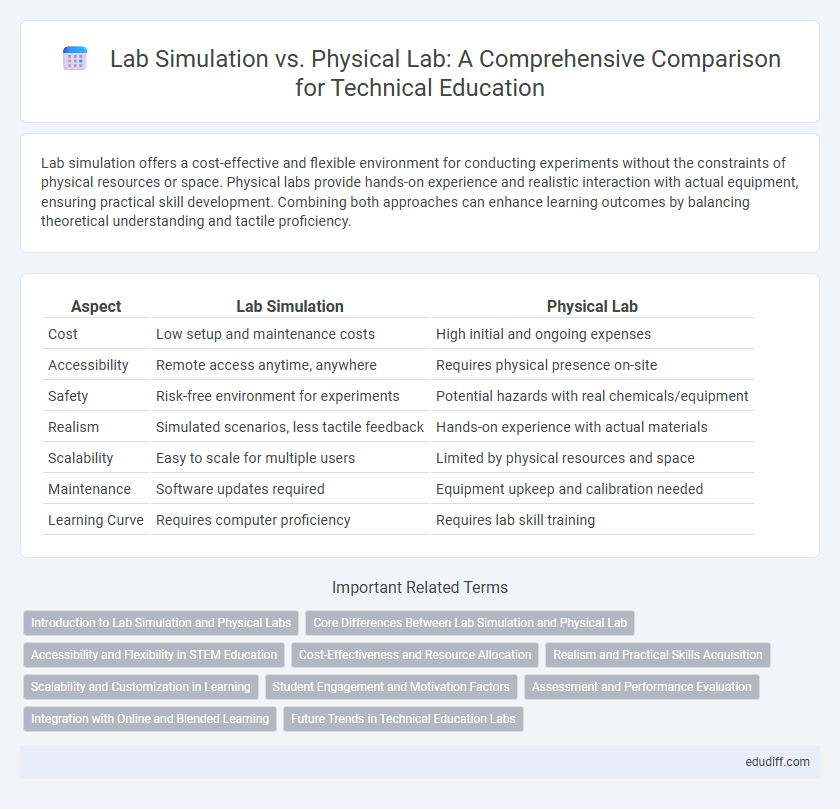Lab simulation offers a cost-effective and flexible environment for conducting experiments without the constraints of physical resources or space. Physical labs provide hands-on experience and realistic interaction with actual equipment, ensuring practical skill development. Combining both approaches can enhance learning outcomes by balancing theoretical understanding and tactile proficiency.
Table of Comparison
| Aspect | Lab Simulation | Physical Lab |
|---|---|---|
| Cost | Low setup and maintenance costs | High initial and ongoing expenses |
| Accessibility | Remote access anytime, anywhere | Requires physical presence on-site |
| Safety | Risk-free environment for experiments | Potential hazards with real chemicals/equipment |
| Realism | Simulated scenarios, less tactile feedback | Hands-on experience with actual materials |
| Scalability | Easy to scale for multiple users | Limited by physical resources and space |
| Maintenance | Software updates required | Equipment upkeep and calibration needed |
| Learning Curve | Requires computer proficiency | Requires lab skill training |
Introduction to Lab Simulation and Physical Labs
Lab simulation employs virtual environments to replicate experimental procedures, allowing for safe, cost-effective, and flexible practice without physical constraints. Physical labs provide hands-on experience with real equipment and materials, offering tangible interaction and immediate feedback essential for mastering experimental techniques. Integrating both methods enhances learning by combining the accessibility of simulations with the realism of in-person experimentation.
Core Differences Between Lab Simulation and Physical Lab
Lab simulation offers a virtual environment where experiments can be conducted using computer-generated models, enabling cost-effective and risk-free testing of scenarios that might be hazardous or impractical in physical labs. Physical labs provide hands-on experience with real equipment, materials, and direct observation of experimental outcomes, which ensures tactile learning and development of manual skills. Key differences lie in accessibility, safety, and realism, with simulations excelling in repeatability and scalability, while physical labs deliver authentic sensory feedback and practical troubleshooting opportunities.
Accessibility and Flexibility in STEM Education
Lab simulations enhance accessibility in STEM education by providing virtual environments that students can access anytime and from anywhere, overcoming geographical and resource limitations. These simulations offer flexibility in experimenting with complex scenarios and repeating procedures without material constraints or safety concerns, fostering deeper conceptual understanding. Physical labs, while essential for tactile learning and hands-on experience, often face scheduling conflicts and limited equipment availability, restricting student interaction opportunities.
Cost-Effectiveness and Resource Allocation
Lab simulation offers a cost-effective alternative to physical labs by reducing expenses related to equipment purchase, maintenance, and consumables. It optimizes resource allocation by enabling multiple users to access virtual experiments simultaneously, minimizing the need for physical space and consumable materials. Physical labs require significant initial investment and ongoing operational costs, limiting accessibility and scalability compared to scalable, budget-friendly simulation platforms.
Realism and Practical Skills Acquisition
Lab simulation offers a controlled environment with precise variable manipulation, enhancing conceptual understanding but often lacks tactile feedback and real-world unpredictability found in physical labs. Physical lab experiences provide hands-on interaction with actual equipment, fostering practical skills and problem-solving abilities critical for real-world applications. Combining both approaches optimizes realism and skill acquisition, bridging theoretical knowledge with tangible practice.
Scalability and Customization in Learning
Lab simulation platforms offer superior scalability by allowing unlimited user access without the constraints of physical space or equipment availability. Customization in virtual labs enables tailored learning experiences through adjustable parameters and diverse scenarios, enhancing educational outcomes across varied student needs. Physical labs, while providing hands-on tactile feedback, are limited in scalability and customization due to fixed resources and time-consuming setup processes.
Student Engagement and Motivation Factors
Lab simulation environments enhance student engagement through interactive, risk-free experimentation, allowing repeated practice that boosts confidence and motivation. Physical labs provide tactile experiences and real-world problem-solving that foster deeper kinesthetic learning and collaboration among students. Combining both approaches optimizes learning outcomes by leveraging the strengths of virtual simulation's accessibility and the hands-on authenticity of physical experimentation.
Assessment and Performance Evaluation
Lab simulation enables real-time data collection and automated performance metrics, facilitating precise assessment of technical skills without the variability seen in physical labs. Physical labs offer hands-on experience and environmental realism critical for evaluating practical problem-solving and equipment handling proficiency. Combining simulation data analytics with physical lab observations yields comprehensive performance evaluations that enhance learning outcomes and skill validation.
Integration with Online and Blended Learning
Lab simulation offers seamless integration with online and blended learning platforms by enabling real-time data sharing, interactive modules, and immediate feedback, which enhances student engagement and comprehension. Physical labs provide tactile experience and hands-on skills that are critical for developing practical expertise but face challenges in flexibility and scalability for remote learners. Combining virtual simulations with physical lab sessions creates a comprehensive learning environment that maximizes accessibility, resource efficiency, and pedagogical effectiveness in technical education.
Future Trends in Technical Education Labs
Future trends in technical education labs emphasize the integration of immersive lab simulations that enhance accessibility and reduce costs compared to physical labs. Advances in virtual reality (VR) and augmented reality (AR) technologies enable highly interactive and scalable simulation environments that replicate real-world technical equipment and experiments. Hybrid models combining digital simulations with physical components are increasingly adopted to provide comprehensive hands-on learning experiences while leveraging data analytics for performance assessment.
Lab Simulation vs Physical Lab Infographic

 edudiff.com
edudiff.com